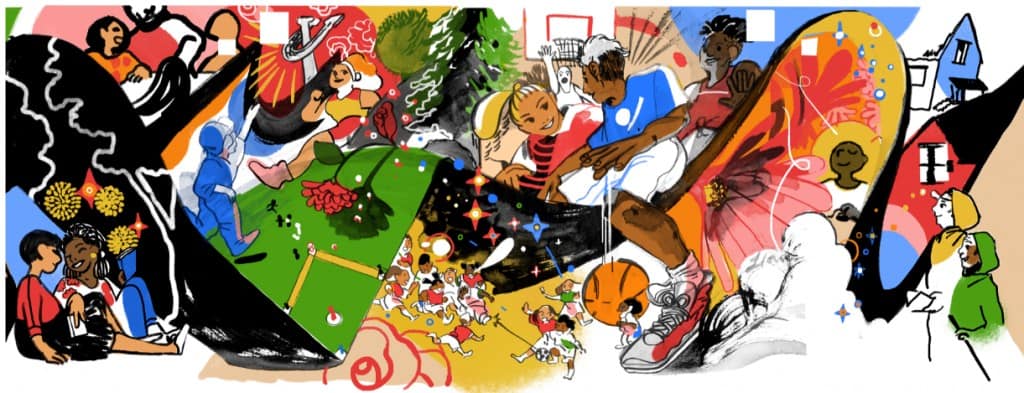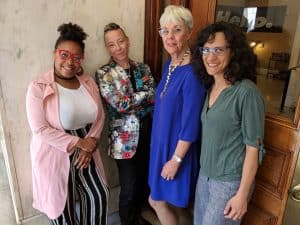
Madison Cario (second from left), with Jennifer Arnold, Charlene Zidell, and Cheryl Green.
Feb. 18, 2020 update:
In the three weeks since announcing our reorganization, we have had a wide range of conversations about the changes and I appreciate the opportunity to reflect on the feedback received to date – please, keep it coming! Reach out anytime at ed@racc.org.
Many stakeholders were consulted over the past year as we considered potential options for RACC. They candidly shared their thoughts with me, with staff, and with board members. Their input helped shape decisions and came from many perspectives, including:
- Leaders of arts organizations in Portland – including many of the small and mid-sized organizations benefiting from changes to RACC’s grantmaking criteria;
- The Portland City Council and other city officials that raised concerns following the release of the Auditor’s 2018 report and initial steps to implement the auditor’s recommendations;
- Funders and leaders of Portland’s philanthropic community;
- Leaders of community-based organizations;
- Peers from other cities with Arts and Culture Council’s – and data recently released by American’s for the Arts on funding for arts organizations around the country.
A number of people have expressed concerns about the RACC staffers laid off as a result of the restructure. I appreciate that concern and I share it. While we can never give details about any individual, I do want you to know that affected staff have been invited to apply – and given preference in the hiring process – for new positions that better support the organization’s new direction and vision. More updates on RACC staffing in the weeks to come.
Posted Jan. 29, 2020
When I first arrived at RACC last January 2019, I was inspired by the people, the diversity of the community, the field and the art forms. A year later, I am still inspired. For a full year I’ve asked people – if you could list the top 3 things that you’d like to have an arts council do to support you and your work, what would that be? Over and over again I was told we need you (RACC) to convene, connect, and bring us together we need you to advocate on our behalf, and we need you to get us more resources! With this in mind we began to imagine how RACC could best fill these gaps.
My charge, as given to me by the board since before my first day in Portland, has been to evaluate RACC’s challenges and opportunities. To develop a strategic plan for RACC to fulfill its responsibility and realize its full potential to advance a thriving, equitable and inclusive arts and culture environment throughout greater Portland.
For the past year I have been listening to artists, nonprofit leaders, and many other folks with big ideas. In meeting rooms from Oregon City to Hillsboro, at gatherings hosted by RACC and at arts events across the region, through “office hours” at local cafes and happy hours at neighborhood hotspots, I’ve been amazed and inspired by the abundance of passion and creativity here. I have heard a strong desire for us all to collectively “do more”.
I also heard, quite frankly, common themes of dissatisfaction with how RACC has been functioning. There are many myths and misunderstandings about what RACC is, what we do, how we do it (spoiler alert: this is the magic) and for whom we are doing things. This confusion contributes to unintended consequences that play out in missed opportunities, inequitable practices, a sense of mistrust and squabbling over resources – both internally and externally. Without clarity and alignment, our brand and our impact are diminished, negatively affecting our staff, our board, our partners and the communities we serve.
A detailed analysis of RACC’s finances this winter, coupled with conversations with staff and board, revealed that we have been supporting programs and projects that are unsustainable. A 2018 audit by the City of Portland, by far our largest funder, revealed a lack of alignment in our goals, and led some to voice uncertainties about the value we provide to the community. The audit paved the way for new levels of city oversight, and as RACC begins to negotiate a new three-year city contract, we have new expectations for stronger accountability, clearer outcomes and greater efficiency going forward. Surely ALL of our community partners want these things, too.
In response to all of these forces, but also looking ahead to achieving our greatest potential, we are charting a new course for RACC and I’m asking for your partnership moving forward.
As you’ll see in our press release, RACC is letting go of some programs and reinvesting resources in other initiatives with stronger impacts. We will continue all of our current grantmaking programs and public art projects, while sunsetting our workplace giving program and eliminating our community engagement program as a separate function of RACC – focusing on collective impact partnerships rather than having a stand-alone program in order to better support communities that have historically been marginalized and underserved.
One change that I am particularly excited about involves transferring all management of The Right Brain Initiative over to Young Audiences of Oregon and SW Washington, RACC’s implementation partner since the Initiative began. This expansion of Young Audiences’ role plays to the strengths of each organization, sustains our long-standing partnership, and ensures continuity for the students, teachers, artists, and schools that we serve.
Combined, these changes will help RACC simplify its operations and focus on what RACC is uniquely positioned to do – be a better advocate and bring more resources into greater Portland’s arts and culture ecosystem. Working on fewer projects means that our staff and board will be better able to support the communities we serve, with a stronger focus on access, customer service, equity, and collective impact.
These changes are not made lightly. We have had to let talented people go – and I am grateful to them for bringing their extraordinary passion and skills to work every day. I am also grateful to our staff, community and board members – past and present – who have all been truthful thought partners and advisors in making some very difficult decisions.
I welcome your feedback and questions as we move in this new direction together. Please reach out anytime at ed@racc.org.

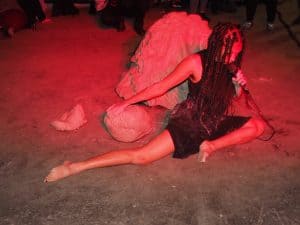 Mississippi/Albina area is historically black neighborhood and was once teeming with culture of black and brown Portlanders. As it stands right now, out of the 80+ that dwell on Mississippi Ave. the only black-owned spaces are Ori Gallery and the St Joseph Grand Lodge (founded in 1940). Ori Gallery has become an act of radical reclamation and a landmark in a city where working-class creatives of color struggle to make space for themselves.
Mississippi/Albina area is historically black neighborhood and was once teeming with culture of black and brown Portlanders. As it stands right now, out of the 80+ that dwell on Mississippi Ave. the only black-owned spaces are Ori Gallery and the St Joseph Grand Lodge (founded in 1940). Ori Gallery has become an act of radical reclamation and a landmark in a city where working-class creatives of color struggle to make space for themselves.
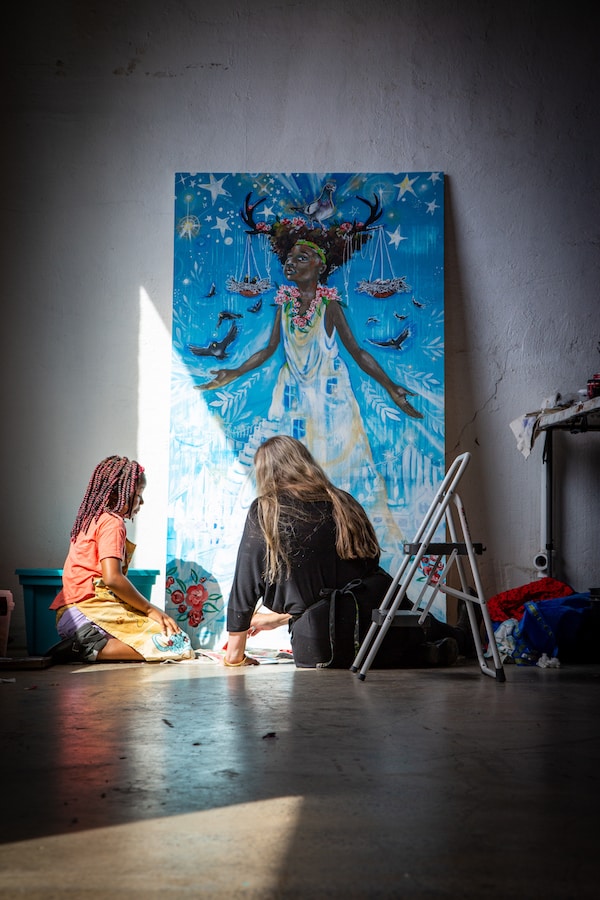
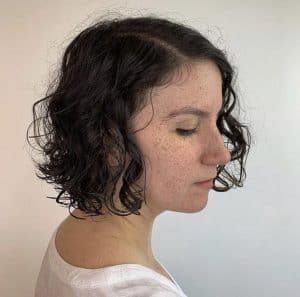 Taryn Sauer is an industrious writer with a copyeditor’s eye and a poet’s hand. Her work has appeared in a variety of newspapers and culinary publications, but what she’s proudest of is the small press zine, Facade, she created with her friends to raise funds for Planned Parenthood. When she’s not writing, you can find her in the kitchen recreating her grandmother’s New Mexican recipes. Check out more of Taryn’s work
Taryn Sauer is an industrious writer with a copyeditor’s eye and a poet’s hand. Her work has appeared in a variety of newspapers and culinary publications, but what she’s proudest of is the small press zine, Facade, she created with her friends to raise funds for Planned Parenthood. When she’s not writing, you can find her in the kitchen recreating her grandmother’s New Mexican recipes. Check out more of Taryn’s work 

